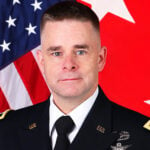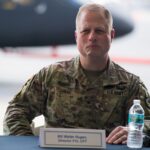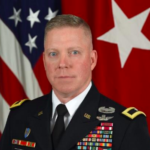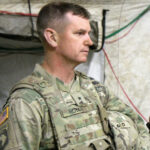New Future Vertical Lift aircraft are just part of the solution. So are new tactics and technology upgrades for existing helicopters.
By SYDNEY J. FREEDBERG JR
WASHINGTON: Drones. Helicopters. Networks. Revolutionary future aircraft. Pressing current missions. Every week, the seven senior officers of the Army's aviation community get together – in person or virtually – to check their collective bearings on all these issues and adjust their course into the future. Last month, I had the privilege of speaking to all seven as part of that weekly meeting.
The “six-pack plus one” represents institutions across the Army:
- Maj. Gen. David Francis heads the helicopter training “schoolhouse” in Fort Rucker, Ala., formally known as the US Army Aviation Center of Excellence.
- Maj. Gen. Todd Royar heads Army Aviation & Missile Command (AMCOM), headquartered at Redstone Arsenal, Ala., which supports maintenance and sustainment Army-wide.
- Brig. Gen. Michael McCurry is director of Army aviation on the Army's headquarters staff in the Pentagon, under the Deputy Chief of Staff of the Army for Operations, Plans, & Training (G3/5/7).
- Brig. Gen. Allan Pepin leads US Army Special Operations Aviation Command (USASOAC), which handles the unique air support needs of special ops forces.
- Col. Robert Barrie is the Deputy Program Executive Officer for PEO Aviation, the Army's aviation acquisition organization; he was standing in for the PEO, Patrick Mason.
- Mr. Geoff Downer directs special operations programs at Army Aviation and Missile Command. He's a member of the Senior Executive Service, making him the civilian equivalent of a general.
- Brig. Gen. Walter Rugen – the “plus one” added in recent years to the longstanding six-pack – heads the newest organization on the list: the Future Vertical Lift Cross Functional Team (FVL CFT) at the 17-month-old Army Futures Command.
“If we have a failure, we have a culture where anybody in the six-pack can raise a red flag of concern,” Brig. Gen. Pepin said. “And if there's concern among the six-pack, we're willing to tell the senior leaders early, so we do not go down the road of lost investments.”
We've used choice pieces of this hour-plus interview in our Future Vertical Lift articles so far, but as we wind up our FVL series, we wanted to give our readers the chance to hear from these leaders at greater length, in their own words (edited for clarity and brevity).

Gen. David Francis
Maj. Gen. David FRANCIS
Commander, US Army Aviation Center of Excellence, Fort Rucker, Ala.:
Speaking with you here today is what we affectionately refer to as the six-pack-plus-one. It's the senior officers that affect every aspect of Army Aviation.
Oftentimes in aviation, we focus on material piece of this, just because of the cost – but you should understand that there are multiple things happening continuously. It's more than just the airframes themselves. There's a whole host of things that we look at, from potentially changing some of our infrastructure in terms of hangers and so forth to accommodate Future Vertical Lift, to how are we going to train?

Brig. Gen. Allan Pepin
Brig. Gen. Allan PEPIN
Commander, US Army Special Operations Aviation Command (USASOAC):
Tactics, techniques, and procedures alone won't allow you to fly into a contested environment and survive. And using technology alone will not let you survive. It has to be a combination of both technology and how we train.
FRANCIS, Aviation Center:
In counterinsurgency operations, the threat has allowed us to operate at altitude, above 1,000 feet, routinely. As we look to large-scale combat operations, we know that the threat will drive us lower [i.e. to evade radar]. That changes the way we train to fight that fight.
When we operate in COIN, we operate in smaller elements [i.e. two helicopters or four on a mission]. When we get to large-scale combat operations, we have to operate more at a battalion level [i.e. 18-24 aircraft]. That means that what we have to be able to do, regardless of the platform, is train to that level of proficiency.
Not only are we training our aviation forces, we're training as part of a combined-arms team — with ground-maneuver elements, with fires, with cyber, and all of the multi-domain things that we're going to bring to bear in a fight.
We are also working, for the first time, on a distinct Aviation supporting concept to talk about how Aviation will fight and contribute in Multi-Domain Operations in 2028. This will all inform the Army concept, which will in turn inform the joint concept that is being written at the joint staff level as we speak.

Brig. Gen. Walter Rugen
Brig. Gen. Walter RUGEN
Director, Future Vertical Lift Cross Functional Team (FVL CFT), Army Futures Command:
We are converging with the other services. It's Joint All Domain Operations, no matter the domain. [The official domains of military operations are land, sea, air, space, and cyberspace – ed.]. We need an interface to communicate critical data, whether that data is sustainment or in the tactical operations realm.
When you look at our lines of effort – the FARA [Future Attack Reconnaissance Aircraft], the future UAS [Unmanned Aerial Systems, i.e. drones], FLRAA [Future Long-Range Assault Aircraft] — those are important. But it really is the ecosystem that they bring.
FRANCIS, Aviation Center:
We know that as we go into a Multi-Domain Operations fight, our enduring fleet – the fleet that we have today, which consists of UH-6OM Black Hawks, AH-64E Apaches and CH-47F Chinooks – stays with us into the 2040s. So not only are we concerned about how we get to Future Vertical Lift, and the capability that brings, we're doing targeted modernization to our enduring fleet.
What we have to do is improve our stand-off and our survivability with the introduction of some technology that will be available prior to the actual FVL platform, like the Long-Range Precision Munition and Air-Launched Effects [i.e. multi-purpose mini-drones].
Those combined, we think, will keep us very, very competitive in that [anti-aircraft] environment until we get the increased speed and survivability of our Future Vertical Lift platforms.
RUGEN, Futures Command:
When we look at ALE and Long-Range Precision Munition, what we're finding, in our modeling and our experimentation at Yuma last year, is you really generate that stand-off and overmatch against threats. We can stay outside their weapon engagement zone and put effects on them.
Air-Launched Effects are what is going to find and fix these threats, and then what the Long-Range Precision Munition is going to do is finish that threat.
In the Presidents' Budget [request for] 2021, there's $152 million dedicated to getting Spike N-LOS missiles into up to three Combat Aviation Brigades in the swiftest possible manner. We're currently projecting that it would be an FY22 initial capability. We're currently projecting that it would be an FY'22 initial [operational] capability. But that's just our initial increment of the Long-Range Precision Munition. We will follow that on with more detailed requirements to fix some of the challenges that we see already with Spike [and] improve upon that capability.
FRANCIS, Aviation Center:
Another example is the ITEP [Improved Turbine Engine Program]. That's going to be the engine that goes into FARA. It's also going to be retrofitted onto our UH-60 and AH-64 fleet. That's an extremely successful, well-funded program that is going to affect both of those fleets.
Another is maintenance. Col. Barrie was the previous program manager for the CH-47. He initiated a process for the CH-47 fleet that is starting to bear results today in reducing the maintenance burden. We're looking to expand that across both our attack and utility fleets as well.

Col. Robert Barrie
Col. Robert BARRIE
Deputy Program Executive Officer, PEO Aviation:
We're finding ways that we can better leverage our investment dollars in the future. We balance the imperative that we have to modernize [with FVL] and the imperative that we have to maintain the readiness of the enduring fleet.
When we're modernizing towards a future capability, are there opportunities [for spin-offs] that can benefit the enduring fleet? In similarly, shame on us if we are doing anything on our enduring fleet that does not reduce the risk for the development of our future fleet.
For example, there's the Aviation Mission Common Server. We can now have processing capability that is government owned and the cost will be significantly reduced. As we go forward, we want to reduce risk on whatever we wind up doing for processing capability on our future fleets, but, in the near term, this allows us a processing capability that we have significantly more control over.

Geoffrey Downer
Mr. Geoff Downer
Director of Special Programs, US Army Aviation and Missile Command (AMCOM):
How do we miniaturize components and gain capability on these other aircraft? We're working on degraded visual environments, electronic counter measures, terrain following, terrain avoidance.
We're losing a lot of aircraft, and about 49 percent of our fatalities, due to degraded visual environment landings [i.e. when the pilot can't see clearly]. So we're actually working to put a degraded visual environment system on the aircraft.
The idea is that they use LIDAR and IR cameras, so when the pilot is landing in a brown-out situation, he can look down and have a synthetic display that shows exactly where the obstacles are, with cues to where he can land and where he can't land. We've done testing, and the feedback from the testing is absolutely remarkable. We believe that this is going to add survivability to our enduring fleet.
RUGEN, Futures Command:
[That said], at the end of the day, we've squeezed everything we can out of these aircraft that were built in an industrial age, a very analog age.
We want survivability in those very contested large-scale combat operations [in the future]. We want to be lethal. We want superior reach, so we want speed, range and endurance at range, in our next generation fleet. That's the aspect that the enduring fleet doesn't bring.
In our survivability studies, with these advanced rotor craft configurations, we basically saw large percentage increases in survivability, from 24 percent to, in some scenarios, nearly 50 percent more survivable — just based on physical characteristics of the aircraft [i.e. not factoring in new electronics, tactics. etc.]
Once our penetration force moves forward, we will generate joint force freedom of maneuver [i.e. not just for the Army, in other words, but for all the services] and our enduring fleet can now start coming forward to help us.

Brig. Gen. Michael McCurry
Brig. Gen. Michael MCCURRY
Director of Army Aviation, Office of the Deputy Chief of Staff of the Army for Operations, Plans, & Training (G3/5/7):
Once we've kind of fractured the Anti-Access/Area Denial piece in Multi-Domain Operations, then we're able to exploit using some of our enduring fleet systems.
That overlap of new and old capabilities — that's not new. I fought in Desert Storm. I flew in OH-58 Kiowa helicopter [which first entered service during Vietnam] and I was teamed with an AH-64 Alpha [which entered service in the 1980s].
We've got to look at, where are the most critical spots to bring capability to first? We will outfit those units [with FVL] first, and then we'll cascade those capabilities throughout the Army.
Gen. FRANCIS, Aviation Center:
As we always done as Army Aviation, you can't field it all at the same time. So there's a sequence to the fielding plans that are developed based on priorities leveled by the G3 [staff] and the Army.
RUGEN, Futures Command:
We want it to be backwards and forwards compatible. We have to be able to extend the network forward and integrate it in a denied environment [i.e. in the face of enemy jamming and hacking].
We've done high-fidelity modeling about how to operate in that environment, with waveforms and architecture that will be resilient. Then we followed that up with an experiment in conjunction with our Special Operations partners up at China Lake. We called it A3I: architecture, autonomy, automation and interfaces.
That system architecture [has] open systems, interfaces, and gateways, so we can push data machine to machine. We're refining our data formats to auto-populate nine-lines [i.e. calls for urgent medical evacuation], calls for fires [i.e. artillery and air strikes], our production, exploitation and dissemination of intelligence.”
Really, the brains behind this is really been our SOF [Special Operations Forces] partners.
DOWNER, Special Programs:
We set up this demonstration in September of last year, using a Black Hawk [helicopter], a Grey Eagle [drone], and a Small Glide Munition [guided bomb]. SOF is still involved in this, we're still using our team, our resources, and the technology that we developed [to build] the network in the sky.
RUGEN, Futures Command:
Then, ultimately, probably one of the hardest things we're going to do is affordability. That gets into our sustainment and logistics concept. Long-term, 68 percent of our total cost of ownership is the sustainment of the fleet.

Then-Brig. Gen. Todd Royar during a 101st Airborne Division exercise.
Maj. Gen. Todd ROYAR
Commander, Army Aviation & Missile Command (AMCOM)
In our current systems, Army Aviation has done a phenomenal job of leading the Army on condition-based maintenance. We are pretty far out there about collecting data and knowing when something is going to fail.
However, we did that by platform, and each individual platform uses a different system to be able to do that. As we move forward, the intent is to go ahead and make sure that we have a common platform for condition-based maintenance. We think this will fundamentally change how maintenance is done, which will ultimately drive down cost.
In the draft documents [on FVL], we have put the hooks in there to make sure that industry knows that that is going to be a requirement. When we send out the proposals to industry, we will direct that certain things be common as far as condition-based maintenance is concerned: what they measure, how they measure it, how the ones to zeros are holding, so that the unit can get that same data, regardless of whether they're looking at FARA, FLRAA, or one of our enduring systems.
That effort is a combination, primarily, between the PEO and my office. We have touchpoints with Future Vertical Lift, to make sure that for the new systems, those requirements are written in. This will be a component of MOSA, the Modular Open Systems Architecture.
RUGEN, Futures Command:
The number one challenge we have with MOSA is discipline and management. What allowed the enduring fleet of aircraft to wind up with different architectures [is] there was not a driving central body that said, “this is the architecture that you are going to go with.” With MOSA, we have that.
It really comes down to defining that government standard, and defining that government interface, and then holding to it. The PEO has led the charge with the architecture control working group, meeting quarterly, with industry participating.
This is aligned with the Network CFT [Cross Functional Team].
PEPIN, Special Ops:
We have to be able to adapt quickly, and that MOSA environment is key. We have to break away from just doing more hardware add-ons to platforms, because it takes an incredible amount of time. [With the Modular Open Systems Architecture], all that's just a software upgrade, you reboot and turn it back on again. You can do it at the speed of need.
https://breakingdefense.com/2020/03/fvl-qa-7-leaders-on-the-future-of-army-aviation







